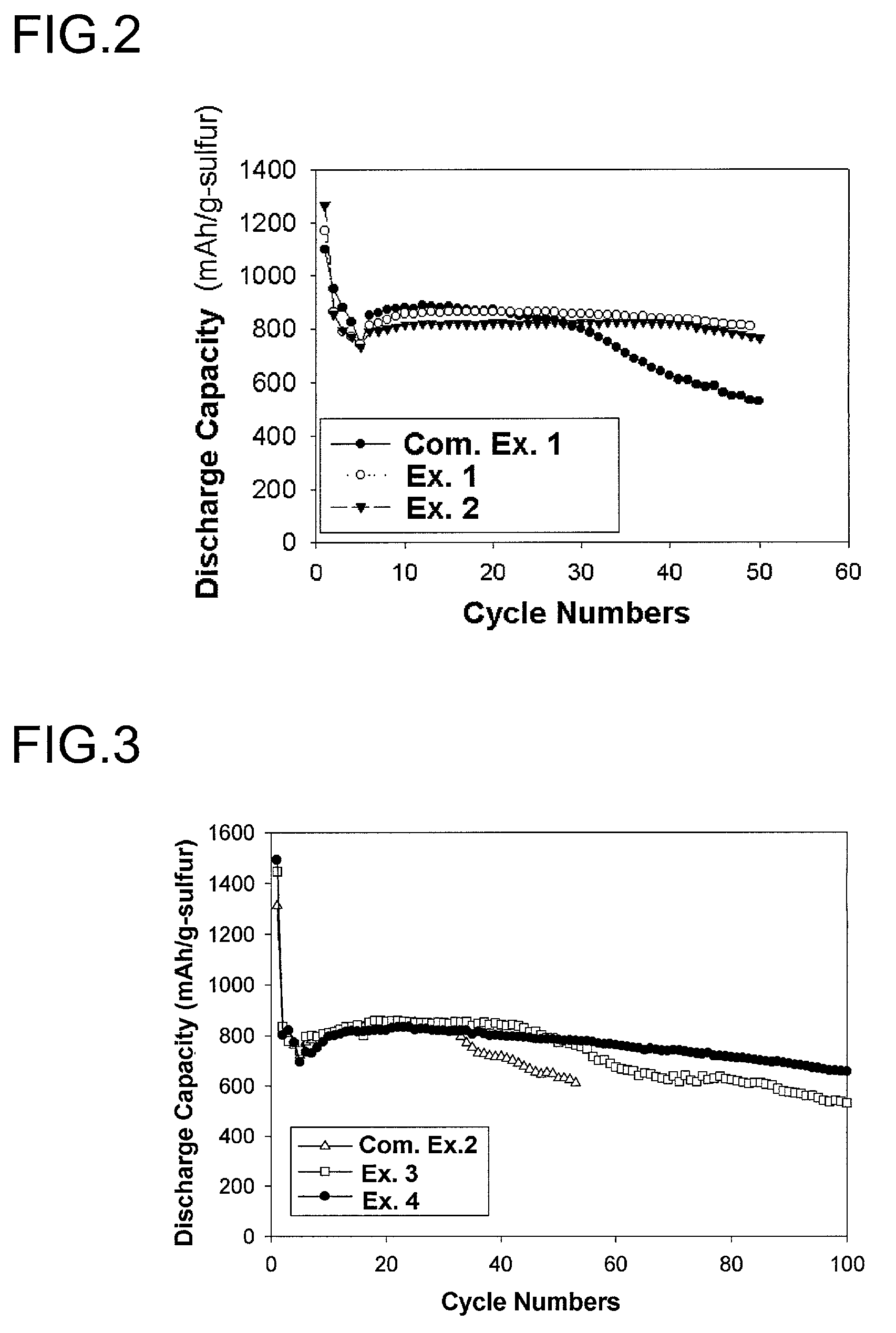Electrolyte for lithium-sulfur batteries and lithium-sulfur batteries comprising the same
a lithium-sulfur battery and lithium-sulfur technology, applied in the field of lithium-sulfur batteries, can solve the problems of lithium-sulfur batteries not being widely commercialized, lithium-sulfur batteries not obtaining satisfactory capacity, high rate performance, cycle life characteristics, etc., and achieves high rate performance, good cycle life characteristics, and high capacity
- Summary
- Abstract
- Description
- Claims
- Application Information
AI Technical Summary
Benefits of technology
Problems solved by technology
Method used
Image
Examples
example 1
[0057]67.5 wt. % elemental sulfur, 11.4 wt. % ketchen black as a conductive material, and 21.1 wt. % polyethylene oxide as a binder were mixed in an acetonitrile solvent to prepare a positive active material slurry for a lithium-sulfur battery cell. The slurry was coated on a carbon-coated Al current collector. The slurry-coated current collector was dried in a vacuum oven at 60° C. for over 12 hours. Thereby, the positive electrode with a current density of 2 mAh / cm2 was prepared to 25×50 mm2 in size. The positive electrode, the vacuum dried separator, and the negative electrode were laminated and transferred into a pouch. An electrolyte of 0.5 M LiSO3CF3 in a mixed solvent of dimethoxyethane / 1-ethyl-3-methylimidazolium bis(perfluoroethyl sulfonyl) imide (EMIBeti) / dioxolane in the volume ratio of 75:5:20 was injected into said pouch. Thereafter, the pouch was sealed and the resultant pouch-type test cell was fabricated.
example 2
[0058]A cell was fabricated by the same procedure as described in Example 1 except that an electrolyte of 0.5 M LiSO3CF3 in a mixed solvent of dimethoxy ethane / EMIBeti / dioxolane in the volume ratio of 70:10:20 was used.
example 3
[0059]A cell was fabricated by the same procedure as described in Example 1 except that an electrolyte of 0.5 M LiPF6 in a mixed solvent of dimethoxy ethane / EMIPF6 / dioxolane in the volume ratio of 75:5:20 was used.
PUM
| Property | Measurement | Unit |
|---|---|---|
| temperatures | aaaaa | aaaaa |
| temperatures | aaaaa | aaaaa |
| temperatures | aaaaa | aaaaa |
Abstract
Description
Claims
Application Information
 Login to View More
Login to View More - R&D
- Intellectual Property
- Life Sciences
- Materials
- Tech Scout
- Unparalleled Data Quality
- Higher Quality Content
- 60% Fewer Hallucinations
Browse by: Latest US Patents, China's latest patents, Technical Efficacy Thesaurus, Application Domain, Technology Topic, Popular Technical Reports.
© 2025 PatSnap. All rights reserved.Legal|Privacy policy|Modern Slavery Act Transparency Statement|Sitemap|About US| Contact US: help@patsnap.com



